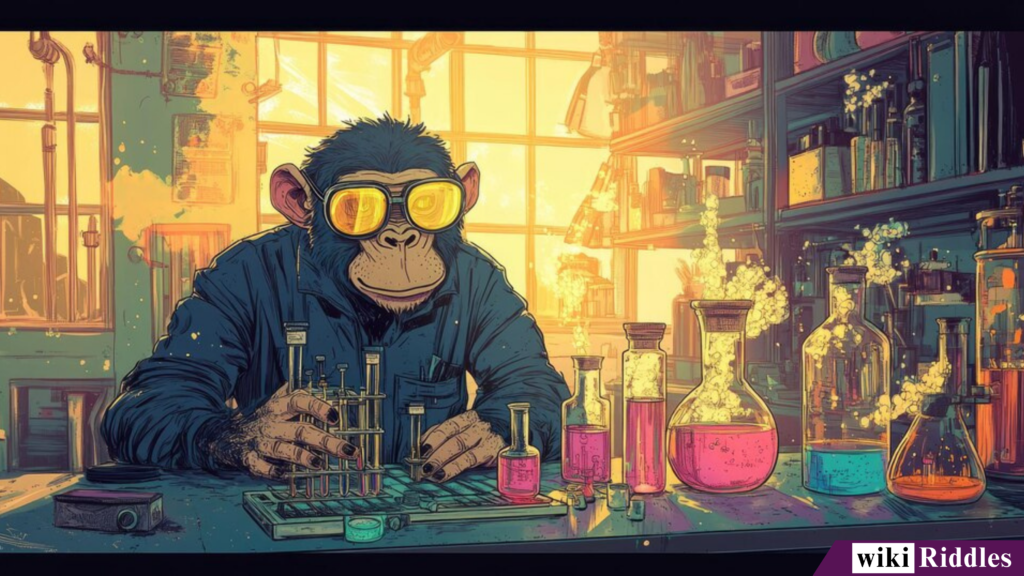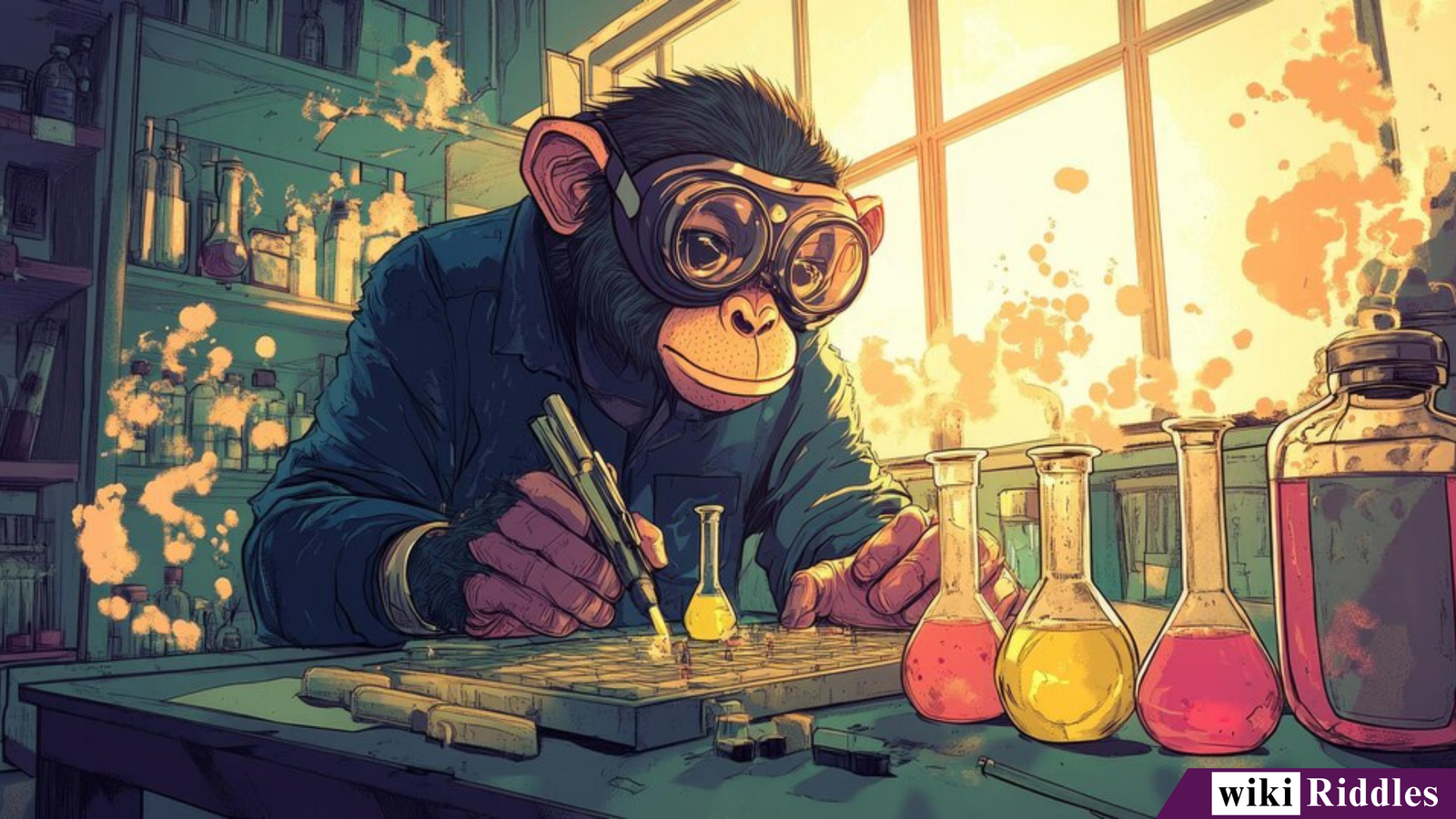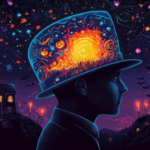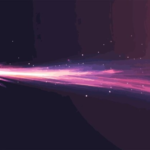Chemistry has always been a subject of intrigue and mystery. But what if you could add a dash of fun to the mix? Enter Chemistry Puzzles, an innovative way to unravel the scientific mysteries that surround us every day. These puzzles are more than just brainteasers—they’re the gateway to understanding the complexities of atoms, molecules, and reactions. So, let’s dive into the world of chemistry puzzles and see why they’re not only educational but also fascinating!

200+ Mysterious “Chemistry Puzzles”
Elemental Enigmas
- Puzzle: I am an element with atomic number 26. I am known for building strong structures, but in the presence of water and air, I slowly deteriorate, turning into reddish-brown flakes. Who am I?
Answer: Iron (Fe). - Puzzle: I am a noble gas, often used to fill balloons and make them float. I am the second lightest element. Who am I?
Answer: Helium (He). - Puzzle: I am an element with atomic number 47, and I am known for my excellent electrical conductivity and shiny appearance. Who am I?
Answer: Silver (Ag). - Puzzle: I am the most reactive halogen, often found in salts and used to disinfect water. What element am I?
Answer: Chlorine (Cl). - Puzzle: I am an element essential for life, found in all organic molecules. I have the atomic number 6. Who am I?
Answer: Carbon (C). - Puzzle: I am the only metal that is liquid at room temperature and was historically used in thermometers. Who am I?
Answer: Mercury (Hg). - Puzzle: I am an element that glows brightly in the dark and was once used to paint watch dials. Who am I?
Answer: Radium (Ra). - Puzzle: I am the lightest element and make up most of the matter in the universe. I am highly flammable. Who am I?
Answer: Hydrogen (H). - Puzzle: I am an element whose symbol comes from the Latin word “aurum,” and I have been used as currency for thousands of years. Who am I?
Answer: Gold (Au). - Puzzle: I am a soft, highly reactive metal found in table salt. I react explosively with water. Who am I?
Answer: Sodium (Na).
Molecular Mysteries
- Puzzle: I am a simple molecule consisting of two hydrogen atoms and one oxygen atom. I can exist as a solid, liquid, or gas, and I am essential for all life forms. What molecule am I?
Answer: Water (H₂O). - Puzzle: I am a molecule made of one carbon atom and two oxygen atoms. I am a byproduct of respiration and a greenhouse gas. What am I?
Answer: Carbon dioxide (CO₂). - Puzzle: I am a simple sugar and a key energy source for living organisms. My chemical formula is C₆H₁₂O₆. What molecule am I?
Answer: Glucose. - Puzzle: I am a molecule made of two nitrogen atoms and one oxygen atom. I am used as a powerful anesthetic in medicine. What molecule am I?
Answer: Nitrous oxide (N₂O). - Puzzle: I am a molecule composed of three oxygen atoms and protect the Earth from harmful ultraviolet radiation. What molecule am I?
Answer: Ozone (O₃). - Puzzle: I am a large biological molecule made of amino acids, essential for muscle development. What macromolecule am I?
Answer: Protein. - Puzzle: I am a molecule found in the air, consisting of two nitrogen atoms. I make up about 78% of the Earth’s atmosphere. What molecule am I?
Answer: Nitrogen (N₂). - Puzzle: I am a molecule that stores and transmits genetic information in living organisms. My structure is a double helix. What molecule am I?
Answer: DNA (Deoxyribonucleic acid). - Puzzle: I am a molecule made of carbon, hydrogen, and oxygen, commonly found in fats and oils. What molecule am I?
Answer: Lipid. - Puzzle: I am a molecule consisting of two atoms of hydrogen and one atom of sulfur. I am known for my distinct rotten egg smell. What molecule am I?
Answer: Hydrogen sulfide (H₂S).
Reaction Riddles
- Puzzle: I am a reaction that occurs when a substance reacts with oxygen, releasing energy in the form of heat and light. What type of reaction am I?
Answer: Combustion. - Puzzle: I am a reaction in which a compound breaks down into two or more simpler substances. What type of reaction am I?
Answer: Decomposition. - Puzzle: I am a reaction where an acid reacts with a base to form water and a salt. What am I?
Answer: Neutralization. - Puzzle: I am a reaction in which two or more simple substances combine to form a more complex compound. What type of reaction am I?
Answer: Synthesis. - Puzzle: I am a reaction in which electrons are transferred from one substance to another, often producing a change in oxidation states. What type of reaction am I?
Answer: Redox (Reduction-Oxidation). - Puzzle: I am a reaction where a substance loses electrons and becomes more positively charged. What am I?
Answer: Oxidation. - Puzzle: I am a reaction in which a solid forms when two solutions are mixed. What am I?
Answer: Precipitation reaction. - Puzzle: I am a reaction that absorbs heat from the surroundings, causing the environment to cool down. What type of reaction am I?
Answer: Endothermic reaction. - Puzzle: I am a reaction that releases energy in the form of heat, making the surroundings warmer. What type of reaction am I?
Answer: Exothermic reaction. - Puzzle: I am a type of reaction where one element replaces another in a compound. What type of reaction am I?
Answer: Single displacement reaction.
Labyrinth of Lab Equipment
- Puzzle: I am a glass container with a narrow neck and a flat bottom, used for mixing, heating, and storing liquids. What piece of lab equipment am I?
Answer: Erlenmeyer flask. - Puzzle: I am a tool used to measure the exact volume of liquids. What am I?
Answer: Graduated cylinder. - Puzzle: I am a piece of equipment used to heat substances in a laboratory. What am I?
Answer: Bunsen burner. - Puzzle: I am a container used to grow microorganisms under controlled conditions. What piece of equipment am I?
Answer: Petri dish. - Puzzle: I am a small tool used to transfer a small amount of liquid, usually drop by drop. What am I?
Answer: Pipette. - Puzzle: I am a device used to hold test tubes upright and secure during an experiment. What am I?
Answer: Test tube rack. - Puzzle: I am a device used to measure the temperature of substances in an experiment. What am I?
Answer: Thermometer. - Puzzle: I am a piece of equipment used to crush and grind solid chemicals into a fine powder. What am I?
Answer: Mortar and pestle. - Puzzle: I am a flat surface made of glass, used to hold objects for examination under a microscope. What am I?
Answer: Microscope slide. - Puzzle: I am a laboratory container with a wide opening, often used for pouring liquids into smaller containers. What am I?
Answer: Beaker.
Periodic Perplexities
- Puzzle: I am the element with the highest electronegativity on the periodic table. What element am I?
Answer: Fluorine (F). - Puzzle: I am the lightest element on the periodic table. What element am I?
Answer: Hydrogen (H). - Puzzle: I am the only metal in Group 1 that is a liquid at room temperature. What element am I?
Answer: Francium (Fr). - Puzzle: I am the first element in Group 18, known for being chemically inert. What element am I?
Answer: Helium (He). - Puzzle: I am the element with atomic number 79, known for my value in jewelry. What element am I?
Answer: Gold (Au). - Puzzle: I am an element that belongs to Group 2 and is used in fireworks to produce bright red flames. What element am I?
Answer: Strontium (Sr). - Puzzle: I am the element with the highest atomic number on the periodic table that occurs naturally. What element am I?
Answer: Uranium (U). - Puzzle: I am the only element that can form stable compounds with itself in long chains, crucial for organic chemistry. What element am I?
Answer: Carbon (C). - Puzzle: I am an element found in chlorophyll and essential for photosynthesis. What element am I?
Answer: Magnesium (Mg). - Puzzle: I am a noble gas used in neon signs, and my symbol is Ne. What element am I?
Answer: Neon (Ne).
Chemical Ciphers
- Puzzle: I am a chemical formula for a molecule that contains two atoms of hydrogen and one atom of oxygen. What am I?
Answer: H₂O (Water). - Puzzle: I am a molecule made up of one carbon atom and four hydrogen atoms. What is my chemical formula?
Answer: CH₄ (Methane). - Puzzle: I am a compound with the formula NaCl. I am commonly found on dining tables. What am I?
Answer: Sodium chloride (Table salt). - Puzzle: I am the chemical formula for glucose, an important source of energy for living organisms. What am I?
Answer: C₆H₁₂O₆. - Puzzle: I am a gas produced during respiration with the chemical formula CO₂. What am I?
Answer: Carbon dioxide. - Puzzle: I am a compound made of calcium, carbon, and oxygen, often found in limestone. What is my chemical formula?
Answer: CaCO₃ (Calcium carbonate). - Puzzle: I am a highly reactive molecule with the formula H₂O₂, commonly used as a disinfectant. What am I?
Answer: Hydrogen peroxide. - Puzzle: I am a molecule made up of two nitrogen atoms and one oxygen atom, often used as an anesthetic. What is my formula?
Answer: N₂O (Nitrous oxide). - Puzzle: I am a compound used in baking with the formula NaHCO₃. What am I?
Answer: Sodium bicarbonate (Baking soda). - Puzzle: I am a molecule responsible for making soft drinks fizzy. My formula is CO₂. What am I?
Answer: Carbon dioxide.
Atomic Anomalies
- Puzzle: I am the only element without neutrons in my most common isotope. What element am I?
Answer: Hydrogen (H). - Puzzle: I am an element that is radioactive and can decay into lead over time. What element am I?
Answer: Uranium (U). - Puzzle: I am the smallest and lightest atom on the periodic table. What element am I?
Answer: Hydrogen (H). - Puzzle: I am the only metal that exists as a liquid at room temperature. What element am I?
Answer: Mercury (Hg). - Puzzle: I am the element that forms diamond and graphite, two allotropes with very different properties. What element am I?
Answer: Carbon (C). - Puzzle: I am an element that has the same number of protons as electrons but different numbers of neutrons. What am I called?
Answer: Isotope. - Puzzle: I am a form of carbon that is harder than steel and conducts electricity. What am I?
Answer: Graphene. - Puzzle: I am an element whose atomic number is higher than its atomic mass. What element am I?
Answer: Hydrogen (H). - Puzzle: I am a rare gas that glows orange-red when an electric current passes through me. What element am I?
Answer: Neon (Ne). - Puzzle: I am an isotope of carbon used to date ancient artifacts. What isotope am I?
Answer: Carbon-14.
Bonding Brainteasers
- Puzzle: I am the strongest type of chemical bond, formed when atoms share pairs of electrons. What type of bond am I?
Answer: Covalent bond. - Puzzle: I am a type of bond where one atom donates an electron to another, often forming between metals and non-metals. What bond am I?
Answer: Ionic bond. - Puzzle: I am a weak bond that occurs between polar molecules, especially important in water. What type of bond am I?
Answer: Hydrogen bond. - Puzzle: I am a type of bond found in metals, where electrons are free to move between atoms, giving metals their conductivity. What type of bond am I?
Answer: Metallic bond. - Puzzle: I am the type of bond that holds the two strands of DNA together. What type of bond am I?
Answer: Hydrogen bond. - Puzzle: I am a type of covalent bond where two pairs of electrons are shared between atoms. What bond am I?
Answer: Double bond. - Puzzle: I am the force of attraction between molecules in close contact, weaker than ionic and covalent bonds. What force am I?
Answer: Van der Waals forces. - Puzzle: I am a type of bond that forms between atoms with a small difference in electronegativity, creating a slight charge difference. What type of bond am I?
Answer: Polar covalent bond. - Puzzle: I am a type of covalent bond where only one pair of electrons is shared between atoms. What type of bond am I?
Answer: Single bond. - Puzzle: I am a special type of covalent bond where both shared electrons come from one atom. What type of bond am I?
Answer: Coordinate covalent bond.
Mystery Compounds
- Puzzle: I am a compound made of sodium and chlorine, commonly used to season food. What compound am I?
Answer: Sodium chloride (NaCl). - Puzzle: I am a compound that releases hydroxide ions when dissolved in water, often used in cleaning products. What compound am I?
Answer: Sodium hydroxide (NaOH). - Puzzle: I am a compound composed of one carbon and two oxygen atoms, released during respiration and combustion. What compound am I?
Answer: Carbon dioxide (CO₂). - Puzzle: I am a compound found in the stomach, essential for digestion, with the formula HCl. What am I?
Answer: Hydrochloric acid. - Puzzle: I am a strong acid used in car batteries and have the formula H₂SO₄. What compound am I?
Answer: Sulfuric acid. - Puzzle: I am a compound that provides plants with nitrogen and is a key ingredient in fertilizers. My formula is NH₄NO₃. What am I?
Answer: Ammonium nitrate. - Puzzle: I am a compound used to make glass and contain silicon and oxygen atoms. What compound am I?
Answer: Silicon dioxide (SiO₂). - Puzzle: I am a compound made from calcium and carbon, commonly found in chalk and limestone. What am I?
Answer: Calcium carbonate (CaCO₃). - Puzzle: I am a poisonous compound used in antifreeze, with the formula C₂H₆O₂. What am I?
Answer: Ethylene glycol. - Puzzle: I am a compound made of iron and oxygen, responsible for rust. What am I?
Answer: Iron oxide (Fe₂O₃).
Toxic Troubles
- Puzzle: I am a highly toxic gas, often referred to as “silent killer,” because I am colorless and odorless. What gas am I?
Answer: Carbon monoxide (CO). - Puzzle: I am a deadly poison that disrupts cellular respiration, often found in certain plants and seeds. What poison am I?
Answer: Cyanide (CN⁻). - Puzzle: I am a heavy metal, toxic to humans, once commonly used in paints and gasoline. What am I?
Answer: Lead (Pb). - Puzzle: I am a gas used in World War I as a chemical weapon, causing severe blistering. What gas am I?
Answer: Mustard gas. - Puzzle: I am a neurotoxin found in certain types of fish, deadly in small doses. What toxin am I?
Answer: Tetrodotoxin. - Puzzle: I am a toxic liquid metal that can cause neurological damage if inhaled or ingested. What am I?
Answer: Mercury (Hg). - Puzzle: I am a poisonous element found in pesticides and can cause cancer. What element am I?
Answer: Arsenic (As). - Puzzle: I am a nerve agent that disrupts the nervous system, used as a chemical weapon. What am I?
Answer: Sarin gas. - Puzzle: I am a highly toxic chemical used in household cleaners, with the formula NaClO. What am I?
Answer: Sodium hypochlorite (Bleach). - Puzzle: I am a radioactive gas that can seep into homes, increasing the risk of lung cancer. What am I?
Answer: Radon (Rn).
Alchemy Adventures
- Puzzle: In ancient alchemy, I was believed to be a magical substance capable of turning base metals into gold. What was I?
Answer: Philosopher’s stone. - Puzzle: Alchemists sought to create me, a liquid believed to grant immortality. What am I?
Answer: Elixir of life. - Puzzle: I am a metal that medieval alchemists tried to transform into gold, often symbolizing human imperfection. What metal am I?
Answer: Lead. - Puzzle: Alchemists believed that I was the process by which impure substances were purified. What was this process called?
Answer: Transmutation. - Puzzle: In alchemical symbolism, I am represented by the symbol of a snake eating its own tail, signifying cycles and eternity. What symbol am I?
Answer: Ouroboros. - Puzzle: I am an ancient concept in alchemy, believed to be the universal solvent capable of dissolving any substance. What was I called?
Answer: Alkahest. - Puzzle: Alchemists believed that I represented the highest state of purity in metals, often associated with gold. What state was I?
Answer: Perfection. - Puzzle: I am the process alchemists used to try to separate pure substances from impurities through heating and cooling. What was this process called?
Answer: Distillation. - Puzzle: Alchemists believed that I could be used to create a homunculus, a small human-like creature. What was I?
Answer: Philosopher’s stone. - Puzzle: I am the celestial body often associated with gold in alchemical traditions. What am I?
Answer: The Sun.
Thermodynamic Twists
- Puzzle: I am a law that states energy cannot be created or destroyed, only transformed. What law am I?
Answer: First law of thermodynamics. - Puzzle: I am the measure of disorder or randomness in a system. What thermodynamic property am I?
Answer: Entropy. - Puzzle: I am a process that occurs when heat is absorbed by a system, causing its temperature to increase. What type of process am I?
Answer: Endothermic process. - Puzzle: I am a process that releases heat to the surroundings, causing the temperature of the surroundings to rise. What type of process am I?
Answer: Exothermic process. - Puzzle: I am a state in which no net heat is exchanged between a system and its surroundings. What state am I?
Answer: Thermal equilibrium. - Puzzle: I am the amount of heat required to raise the temperature of one gram of a substance by one degree Celsius. What am I?
Answer: Specific heat capacity. - Puzzle: I am the point at which the solid, liquid, and gas phases of a substance coexist in equilibrium. What point am I?
Answer: Triple point. - Puzzle: I am the law that relates pressure, volume, and temperature in a closed system of gas. What law am I?
Answer: Ideal gas law. - Puzzle: I am the theoretical temperature at which all molecular motion ceases. What am I?
Answer: Absolute zero. - Puzzle: I am the energy transferred between two objects due to a temperature difference. What am I?
Answer: Heat.
Catalyst Conundrums
- Puzzle: I am a substance that speeds up a chemical reaction without being consumed. What am I?
Answer: Catalyst. - Puzzle: I am a biological catalyst that speeds up reactions in living organisms. What am I?
Answer: Enzyme. - Puzzle: I am a catalyst that only works when finely divided into small particles to increase surface area. What type of catalyst am I?
Answer: Heterogeneous catalyst. - Puzzle: I am a catalyst that exists in the same phase as the reactants, often in liquid solutions. What type of catalyst am I?
Answer: Homogeneous catalyst. - Puzzle: I am a catalytic process that converts nitrogen gas into ammonia, essential for fertilizers. What process am I?
Answer: Haber process. - Puzzle: I am a catalyst made of platinum, commonly used in car exhaust systems to reduce harmful emissions. What am I?
Answer: Catalytic converter. - Puzzle: I am a type of catalyst that increases the rate of reaction by providing an alternative pathway with a lower activation energy. What am I?
Answer: Transition state catalyst. - Puzzle: I am a catalyst used to break down hydrogen peroxide into water and oxygen in cells. What enzyme am I?
Answer: Catalase. - Puzzle: I am a catalytic process used in the petroleum industry to break down large hydrocarbon molecules into smaller ones. What process am I?
Answer: Catalytic cracking. - Puzzle: I am a biological process that uses light and chlorophyll as a catalyst to convert carbon dioxide and water into glucose. What process am I?
Answer: Photosynthesis.
Polymer Puzzles
- Puzzle: I am a type of polymer used to make plastic bottles and synthetic fibers, often labeled as PET. What polymer am I?
Answer: Polyethylene terephthalate (PET). - Puzzle: I am a natural polymer found in plants, providing structural support in the cell walls. What polymer am I?
Answer: Cellulose. - Puzzle: I am a synthetic polymer often used in packaging materials, and my name means “many styrenes.” What polymer am I?
Answer: Polystyrene. - Puzzle: I am a type of polymer that can be stretched into long fibers, often used in clothing. What polymer am I?
Answer: Nylon. - Puzzle: I am a polymer made of repeating units of isoprene, commonly used in tires. What polymer am I?
Answer: Natural rubber. - Puzzle: I am a polymer used in the production of nonstick coatings, like in cookware. What polymer am I?
Answer: Polytetrafluoroethylene (Teflon). - Puzzle: I am a biopolymer that stores genetic information in living organisms. What polymer am I?
Answer: DNA (Deoxyribonucleic acid). - Puzzle: I am a flexible polymer used in toys like Silly Putty, made from silicon-based compounds. What polymer am I?
Answer: Silicone. - Puzzle: I am a polymer used in disposable diapers due to my ability to absorb and retain water. What polymer am I?
Answer: Sodium polyacrylate. - Puzzle: I am a polymer commonly found in hair, nails, and animal horns. What polymer am I?
Answer: Keratin.
Electrochemical Escapes
- Puzzle: I am the type of chemical reaction that occurs in batteries to produce electrical energy. What type of reaction am I?
Answer: Redox reaction (Reduction-Oxidation). - Puzzle: I am the part of the battery where oxidation takes place. What am I called?
Answer: Anode. - Puzzle: I am the electrolyte used in lead-acid car batteries. What substance am I?
Answer: Sulfuric acid (H₂SO₄). - Puzzle: I am the process by which electrical energy is used to drive a non-spontaneous chemical reaction. What am I?
Answer: Electrolysis. - Puzzle: I am the device used to measure the electrical potential difference between two points in a circuit. What am I?
Answer: Voltmeter. - Puzzle: I am a common metal used in electroplating to prevent corrosion, often applied as a protective coating. What metal am I?
Answer: Zinc. - Puzzle: I am the part of a fuel cell where the reduction of oxygen takes place. What am I called?
Answer: Cathode. - Puzzle: I am a solution that conducts electricity by allowing the movement of ions. What type of solution am I?
Answer: Electrolyte. - Puzzle: I am the process of rusting in metals, which involves oxidation. What is this process called?
Answer: Corrosion. - Puzzle: I am the electrochemical process used to separate pure aluminum from bauxite ore. What is this process called?
Answer: Hall-Héroult process.
Radioactive Riddles
- Puzzle: I am the process by which unstable atomic nuclei lose energy by emitting radiation. What process am I?
Answer: Radioactive decay. - Puzzle: I am a type of radiation that consists of two protons and two neutrons. What type of radiation am I?
Answer: Alpha radiation (α). - Puzzle: I am the radioactive element used in smoke detectors, with an atomic number of 95. What element am I?
Answer: Americium (Am). - Puzzle: I am the unit used to measure the activity of a radioactive substance. What unit am I?
Answer: Becquerel (Bq). - Puzzle: I am the radiation that has no mass or charge and can penetrate deeply into materials. What type of radiation am I?
Answer: Gamma radiation (γ). - Puzzle: I am the radioactive isotope of hydrogen, often used in nuclear fusion reactions. What isotope am I?
Answer: Tritium (³H). - Puzzle: I am the scientist who discovered the radioactive elements polonium and radium. Who am I?
Answer: Marie Curie. - Puzzle: I am the half-life of a radioactive isotope, defined as the time it takes for half of the substance to decay. What is this period called?
Answer: Half-life. - Puzzle: I am a highly radioactive metal used as fuel in nuclear power plants. What element am I?
Answer: Uranium (U). - Puzzle: I am the phenomenon in which a neutron strikes a nucleus, causing it to split and release energy. What am I?
Answer: Nuclear fission.
Lab Disaster Mysteries
- Puzzle: In a lab, I accidentally mixed two chemicals, producing a toxic gas. The reaction involved bleach and ammonia. What toxic gas was produced?
Answer: Chloramine gas. - Puzzle: I heated a closed container without venting it, causing a dangerous buildup of pressure. What could happen next?
Answer: The container could explode due to overpressure. - Puzzle: While working in a chemistry lab, I noticed a liquid catching fire when exposed to air. What type of substance was it?
Answer: A pyrophoric substance. - Puzzle: I accidentally spilled concentrated sulfuric acid on the lab bench, and it started to react violently with the wood. What is causing this reaction?
Answer: The acid is dehydrating the organic material in the wood, causing heat and charring. - Puzzle: I mixed two chemicals and saw a sudden burst of flames without any external ignition. What type of reaction is this?
Answer: A combustion reaction. - Puzzle: I was handling a liquid that evaporated rapidly and caused frostbite upon skin contact. What type of substance was it?
Answer: A cryogenic liquid. - Puzzle: I mishandled a reactive metal that exploded when it came into contact with water. What metal was it?
Answer: Sodium (Na). - Puzzle: I noticed an unusual smell in the lab after a chemical spill, and my vision started to blur. What type of hazard am I experiencing?
Answer: Exposure to a volatile toxic chemical. - Puzzle: I spilled a chemical on the lab floor, and it began to fizz and bubble. What is likely happening?
Answer: A chemical reaction with the floor material, possibly involving an acid-base reaction. - Puzzle: A bottle of nitric acid was exposed to sunlight, and I noticed brown fumes. What gas was released?
Answer: Nitrogen dioxide (NO₂).
Acid-Base Dilemmas
- Puzzle: I am an acid that is commonly found in citrus fruits. What acid am I?
Answer: Citric acid. - Puzzle: I am the base used in soap making, with the formula NaOH. What am I?
Answer: Sodium hydroxide. - Puzzle: I am a weak acid used as a preservative in pickling foods. What acid am I?
Answer: Acetic acid. - Puzzle: I am a pH indicator that turns pink in basic solutions and colorless in acidic solutions. What am I?
Answer: Phenolphthalein. - Puzzle: I am the acid in your stomach that helps digest food. What acid am I?
Answer: Hydrochloric acid (HCl). - Puzzle: I am the scale used to measure how acidic or basic a substance is. What scale am I?
Answer: pH scale. - Puzzle: I am a base that neutralizes stomach acid and is often used as an antacid. What base am I?
Answer: Magnesium hydroxide. - Puzzle: I am a strong acid commonly used in car batteries. What acid am I?
Answer: Sulfuric acid (H₂SO₄). - Puzzle: I am the base used in baking powder to help baked goods rise. What am I?
Answer: Sodium bicarbonate (Baking soda). - Puzzle: I am the process by which an acid reacts with a base to produce water and a salt. What is this process called?
Answer: Neutralization.
Chemical Engineering Challenges
- Puzzle: I am a chemical reactor designed to carry out continuous reactions over long periods. What type of reactor am I?
Answer: Continuous stirred-tank reactor (CSTR). - Puzzle: I am a heat exchanger that uses a flowing liquid or gas to remove heat from a process. What type of device am I?
Answer: Cooling tower. - Puzzle: I am a device used in oil refineries to separate different hydrocarbon fractions based on boiling point. What device am I?
Answer: Fractional distillation column. - Puzzle: I am the law that describes the relationship between pressure, volume, and temperature in gases. What law am I?
Answer: Ideal gas law. - Puzzle: I am the process of removing dissolved ions from water using a semi-permeable membrane. What process am I?
Answer: Reverse osmosis. - Puzzle: I am the energy-efficient process used to separate components in a mixture by applying a magnetic field. What am I?
Answer: Magnetic separation. - Puzzle: I am the process of converting natural gas into liquid hydrocarbons, often used in fuel production. What process am I?
Answer: Fischer-Tropsch synthesis. - Puzzle: I am a chemical process that converts crude oil into valuable products like gasoline and diesel. What process am I?
Answer: Cracking. - Puzzle: I am the term used to describe the maximum amount of solute that can dissolve in a solvent at a given temperature. What am I?
Answer: Solubility. - Puzzle: I am a high-pressure process used in chemical engineering to create ammonia from nitrogen and hydrogen gases. What process am I?
Answer: Haber process.
Spectroscopy Secrets
- Puzzle: I am the technique used to determine the structure of molecules by measuring their interaction with infrared radiation. What technique am I?
Answer: Infrared (IR) spectroscopy. - Puzzle: I am the analytical method used to measure the concentration of elements by ionizing the sample with a flame. What method am I?
Answer: Flame atomic absorption spectroscopy (AAS). - Puzzle: I am the spectroscopic technique used to observe the energy levels of atomic nuclei. What technique am I?
Answer: Nuclear magnetic resonance (NMR) spectroscopy. - Puzzle: I am the region of the electromagnetic spectrum used in ultraviolet-visible (UV-Vis) spectroscopy. What is this region called?
Answer: Ultraviolet and visible light regions. - Puzzle: I am the technique used to analyze the interaction of X-rays with crystal lattices to determine molecular structure. What am I?
Answer: X-ray crystallography. - Puzzle: I am a spectroscopic technique that measures the energy change when electrons are excited from one orbital to another. What am I?
Answer: UV-Vis spectroscopy. - Puzzle: I am the technique used to measure the masses of individual molecules by ionizing them and sorting the ions based on their mass-to-charge ratio. What am I?
Answer: Mass spectrometry. - Puzzle: I am the type of spectroscopy that uses microwaves to determine the rotational transitions of molecules. What technique am I?
Answer: Microwave spectroscopy. - Puzzle: I am the analytical method used to detect and measure isotopes by separating them based on their mass and charge. What am I?
Answer: Isotope-ratio mass spectrometry. - Puzzle: I am the spectroscopic technique used to analyze the interaction of matter with electromagnetic radiation across a wide range of frequencies. What am I?
Answer: Electromagnetic spectroscopy.
What Are Chemistry Puzzles?
Chemistry puzzles are challenges or problems based on chemical concepts, principles, and reactions. They could be anything from decoding molecular structures, predicting chemical reactions, or solving riddles that involve periodic table elements. Think of them as scientific puzzles designed to stretch your brain and deepen your understanding of chemistry.
Why Chemistry Puzzles Are Important
Why should you care about chemistry puzzles? Well, they make learning fun! Instead of memorizing complex theories, puzzles help you think critically and apply knowledge to solve problems. They encourage out-of-the-box thinking and push you to see connections that aren’t immediately obvious. Plus, they help make abstract concepts more concrete, which is why both students and professionals find them so valuable.
The Fascination Behind Chemistry Puzzles
There’s something mysterious and captivating about chemistry puzzles that draws you in. They make you feel like a detective on the trail of a breakthrough discovery, where every clue brings you closer to solving a mystery.
- The Intrigue of Solving Scientific Mysteries
Chemistry itself is full of mysteries, from the origins of life to how certain reactions occur in nature. Chemistry puzzles mirror this intrigue by challenging you to think like a scientist, piecing together clues to solve a problem. The satisfaction of solving a complex chemistry puzzle is similar to that of unlocking a secret code—there’s an “aha!” moment that’s hard to beat.
- Examples of Famous Chemistry Puzzles in History
Throughout history, there have been numerous chemistry puzzles that took decades or even centuries to solve. For instance, Dmitri Mendeleev’s periodic table started as a puzzle: how could he arrange elements in a way that made sense of their properties? Similarly, the mystery of DNA’s double-helix structure was essentially a chemistry puzzle that James Watson and Francis Crick famously solved in 1953.
How Chemistry Puzzles Stimulate Problem-Solving
One of the greatest benefits of chemistry puzzles is how they foster problem-solving skills. Whether you’re a student, researcher, or hobbyist, these puzzles force you to approach problems methodically and logically.
- Encouraging Critical Thinking and Analytical Skills
Solving chemistry puzzles is like putting together pieces of a scientific jigsaw. You need to analyze the data, recognize patterns, and use logical reasoning to reach a conclusion. This kind of critical thinking is essential in scientific research and everyday problem-solving.
- Developing Creativity in Solving Scientific Problems
While chemistry is often thought of as rigid and rule-based, there’s actually a lot of room for creativity. Chemistry puzzles often require innovative thinking to come up with solutions, as not every problem has an obvious or straightforward answer. This creativity can lead to real-life applications, from developing new materials to discovering groundbreaking pharmaceuticals.
Common Types of Chemistry Puzzles
There are countless types of chemistry puzzles, each targeting different aspects of chemical knowledge. Whether you’re a beginner or an expert, there’s something for everyone.
- Molecular Structures and Chemical Bonds
One common type of chemistry puzzle involves figuring out the molecular structure of compounds. These puzzles challenge you to arrange atoms in a way that satisfies all bonding requirements, helping you understand the nuances of molecular geometry and bonding.
- Periodic Table Challenges
Periodic table puzzles are another popular type. They often involve arranging elements based on their properties or predicting trends across periods and groups. These challenges sharpen your understanding of how the periodic table is organized and the relationships between elements.
- Reaction Mechanisms and Equilibrium Puzzles
Some puzzles focus on reaction mechanisms, requiring you to predict the outcome of a chemical reaction. These are perfect for chemistry enthusiasts who love diving deep into the behavior of molecules during reactions. Equilibrium puzzles, on the other hand, ask you to determine how different factors like temperature or pressure will affect a system at equilibrium.
Chemistry Puzzles in Education
Chemistry puzzles aren’t just for fun—they’re also a powerful educational tool.
- Why Teachers Use Chemistry Puzzles in Classrooms
Many teachers use chemistry puzzles as part of their curriculum because they engage students in active learning. Instead of passively absorbing information, students are encouraged to solve problems on their own, which leads to deeper understanding.
- Benefits for Students in Learning Chemistry Through Puzzles
Puzzles help students grasp difficult concepts by forcing them to apply their knowledge in practical ways. For example, instead of memorizing the periodic table, students working on a puzzle may need to figure out why one element behaves differently than another. This hands-on approach improves retention and understanding.
- Real-Life Examples of Chemistry Puzzles Used in Schools
In classrooms around the world, teachers use puzzles to teach everything from basic atomic structure to complex chemical reactions. For instance, some teachers create escape-room-style challenges where students have to solve chemistry puzzles to “escape” the room—combining fun and education.
Chemistry Puzzles for Fun and Entertainment
Who said learning can’t be fun? Chemistry puzzles aren’t just for students; they’re also great for anyone who enjoys a challenge.
- How to Incorporate Chemistry into Games
Believe it or not, you can turn chemistry puzzles into engaging games. Board games, trivia quizzes, and escape room challenges all lend themselves to chemistry-based puzzles. These games offer a lighthearted way to explore complex scientific concepts without feeling like you’re in a classroom.
- Puzzles for All Ages: From Beginners to Experts
Whether you’re just starting to learn chemistry or you’re a seasoned professional, there’s a chemistry puzzle out there for you. Beginners might enjoy simple puzzles involving atomic structures, while experts can dive into more complex reaction mechanisms and thermodynamic challenges.
Online Resources and Chemistry Puzzle Apps
The internet is full of resources to challenge your chemistry knowledge. From websites to mobile apps, there’s no shortage of tools to keep your mind sharp.
- Best Websites for Chemistry Puzzles
Some of the best websites for chemistry puzzles include resources like ChemCollective and Khan Academy, which offer interactive puzzles that range from balancing chemical equations to solving complex reaction problems.
- Popular Apps to Challenge Your Chemistry Skills
Apps like ChemCaper and Chemist are perfect for mobile learners. They offer puzzles and games designed to improve your understanding of chemistry, making learning accessible and fun.
The Future of Chemistry Puzzles
With advances in technology, chemistry puzzles are evolving, becoming more interactive and engaging than ever.
- Innovations in Chemistry Learning Through Technology
Virtual reality (VR) and augmented reality (AR) are being integrated into chemistry education, offering immersive experiences where students can manipulate molecules and observe reactions in 3D. These technologies bring chemistry puzzles to life in ways we could never have imagined.
- The Role of Chemistry Puzzles in Future Scientific Breakthroughs
As scientific challenges become more complex, chemistry puzzles will continue to play a crucial role in training the next generation of chemists. These puzzles are not just games—they’re exercises in critical thinking that could lead to the next major discovery in medicine, materials science, or environmental chemistry.
Conclusion
In conclusion, exploring these 200+ mysterious chemistry puzzles is a great way to sharpen your problem-solving skills while deepening your understanding of chemical concepts. Whether you’re a student, educator, or simply someone with a passion for science, these puzzles offer both entertainment and learning. If you enjoyed this collection, be sure to check out 200+ “The More You Take, More You Leave Behind” Riddles for more brain-teasing challenges to keep your mind engaged!
FAQs
Q. What are some examples of chemistry puzzles for beginners?
Some beginner-friendly chemistry puzzles include balancing chemical equations, identifying elements based on their symbols, and basic molecular structure puzzles.
Q. How can chemistry puzzles help with scientific research?
Chemistry puzzles sharpen problem-solving skills and encourage creative thinking, which are essential when conducting scientific research, especially when dealing with complex chemical reactions or unknown substances.
Q. Are chemistry puzzles useful for high school students?
Yes, chemistry puzzles are an excellent tool for high school students. They help reinforce key concepts, improve critical thinking, and make learning more interactive and enjoyable.
Q. What are some fun chemistry puzzle games?
Games like ChemCaper, Elemental Escape Rooms, and Periodic Table Bingo offer a fun and engaging way to learn chemistry through puzzles and challenges.
Q. Where can I find chemistry puzzles online for free?
Websites like ChemCollective, Khan Academy, and Ptable offer free chemistry puzzles and interactive challenges suitable for all levels of learners.










